When you sit across from a potential client, you’re not just discussing carats and settings—you’re uncovering the essence of who they are. Every gesture, every word choice, and every pause reveals vital information about their personality type. The way they describe their lifestyle, touch existing pieces, or react to design concepts becomes your roadmap for creating something truly meaningful. But here’s what most designers miss entirely.
The Art of Listening During Client Consultations
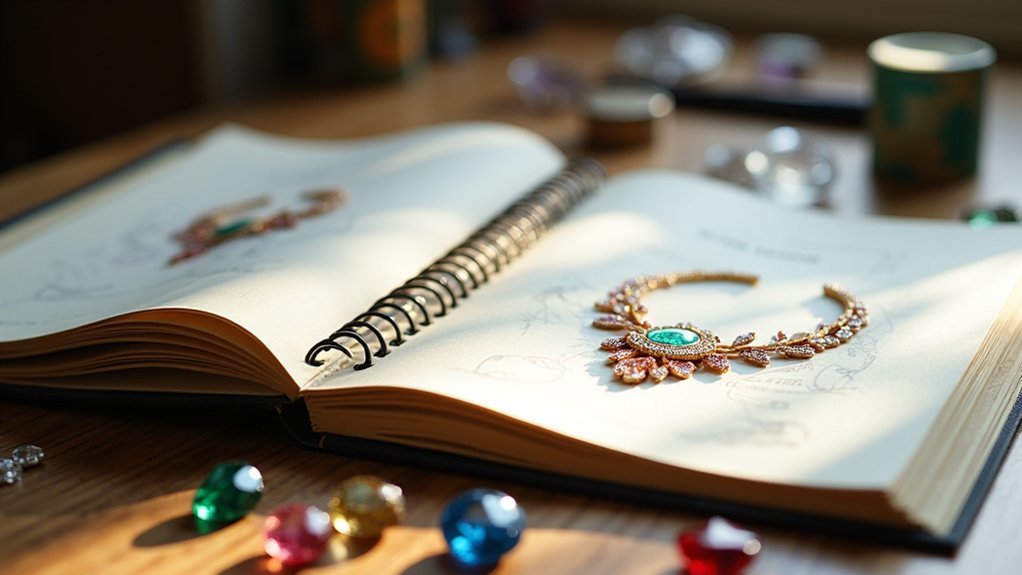
Every word your client speaks during a consultation holds the potential to reveal a deeply personal story that’ll transform raw materials into meaningful jewelry.
You’ll discover treasured memories about loved ones, significant life events, and emotional connections that shape their vision. Through active listening, you’ll ask open-ended questions that encourage deeper sharing, allowing their authentic narrative to emerge naturally.
Every treasured memory and emotional connection your client shares becomes the foundation for jewelry that authentically reflects their personal story.
Watch for emotional cues that signal when clients aren’t ready for major decisions, especially regarding heirlooms or pieces connected to loss. Sometimes you’ll need to decline projects that compromise your integrity or stem from negative emotions.
When you truly listen and reflect their stories back, you’ll guarantee each piece of jewelry captures the intended emotional depth, creating designs that genuinely resonate with their identity.
Identifying the Sentimental Jewelry Lover
How can you spot a client whose jewelry choices stem from the heart rather than fashion trends?
Listen for personal stories attached to every piece they mention. They’ll describe their grandmother’s ring or share how one pair of earrings reminds them of a special anniversary.
These clients view jewelry as emotional anchors, not mere accessories.
Watch for clients who ask about customizing pieces with birthstones, engravings, or incorporating elements from existing jewelry.
They’re drawn to pieces you choose that can commemorate relationships, milestones, or meaningful locations.
They often worry about losing jewelry because each piece represents irreplaceable memories.
Their consultation conversations revolve around “what this means” rather than “how this looks,” revealing their sentimental nature immediately.
Working With the Fully Dressed Client
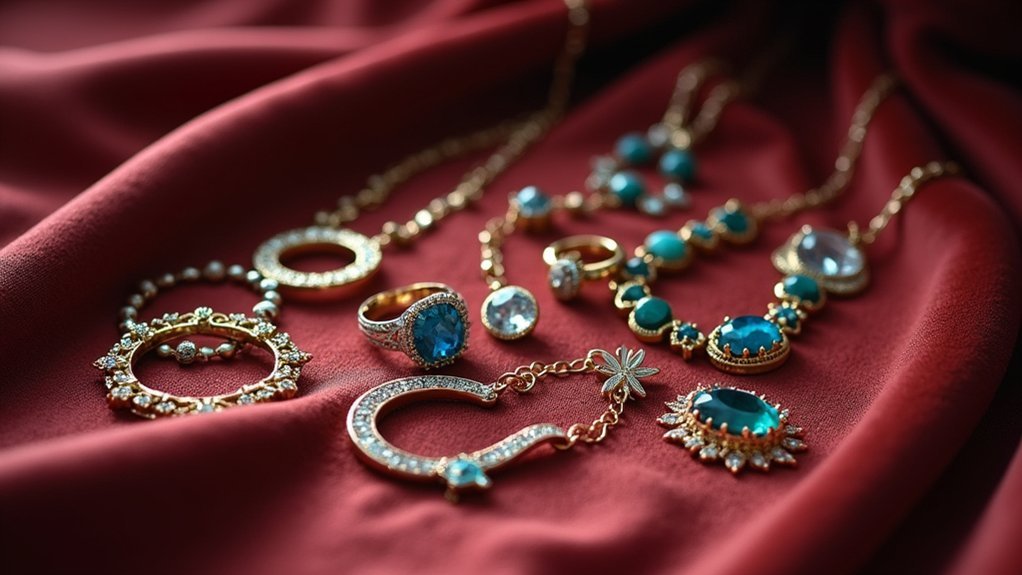
You’ll instantly recognize the Fully Dressed client by their unwavering belief that jewelry isn’t optional—it’s mandatory.
They can’t leave the house without their carefully chosen pieces because accessories complete their identity and daily armor.
When working with these clients, understand that missing jewelry creates genuine distress, as they view adornments as essential as clothing itself.
Daily Jewelry Essentials
When working with the Fully Dressed client, you’re designing for someone who views jewelry as non-negotiable daily armor. These clients integrate accessories into their morning routine like brushing teeth – it’s essential for feeling complete. Missing their staple pieces leaves them feeling unprepared and incomplete.
Focus on versatile designs that shift seamlessly from day to night. Your pieces should align with their personal aesthetic while offering comfort for extended wear.
| Essential Category | Design Focus | Key Features |
|---|---|---|
| Statement Earrings | Elegant versatility | Lightweight, secure closures |
| Signature Necklaces | Personal expression | Adjustable lengths, durable chains |
| Layered Bracelets | Functional fashion | Comfortable fit, stackable designs |
Create pieces that blend aesthetics with wearability, ensuring your designs become their trusted daily companions.
Incomplete Without Adornments
Although the Fully Dressed client appears confident and put-together, their relationship with jewelry runs deeper than surface aesthetics.
You’ll notice these clients experience genuine distress when they forget to wear their regular pieces. They’ve integrated jewelry into their morning routine so completely that stepping out without earrings or a watch feels like leaving home half-dressed.
This emotional connection presents you with unique design opportunities.
These clients don’t just want beautiful pieces—they need jewelry that enhances their attractiveness and complements their daily style. They’ll invest in versatile collections that adapt to different moods and outfits.
Understanding their desire for completeness means you can create essential pieces that become irreplaceable parts of their identity, ensuring long-term client loyalty.
Understanding the Good Mood Jewelry Enthusiast
A radiant smile isn’t the only way to broadcast happiness—jewelry becomes a powerful extension of joy for the Good Mood Jewelry Enthusiast. When you’re designing for this personality, you’ll notice they choose pieces that mirror their emotional highs. Their jewelry selections aren’t random; they’re intentional mood boosters that create positive social experiences.
| Emotional State | Jewelry Choice | Social Impact |
|---|---|---|
| Celebratory | Bold statement pieces | Conversation starter |
| Confident | Vibrant colored gems | Attracts compliments |
| Playful | Unique, eye-catching designs | Enhances interactions |
You’ll find these clients gravitating toward pieces that amplify their uplifting moments. They understand that jewelry serves dual purposes: personal mood enhancement and social signaling. When they wear your designs, they’re not just accessorizing—they’re broadcasting their inner light to the world.
Designing for the Expressive Personality Type
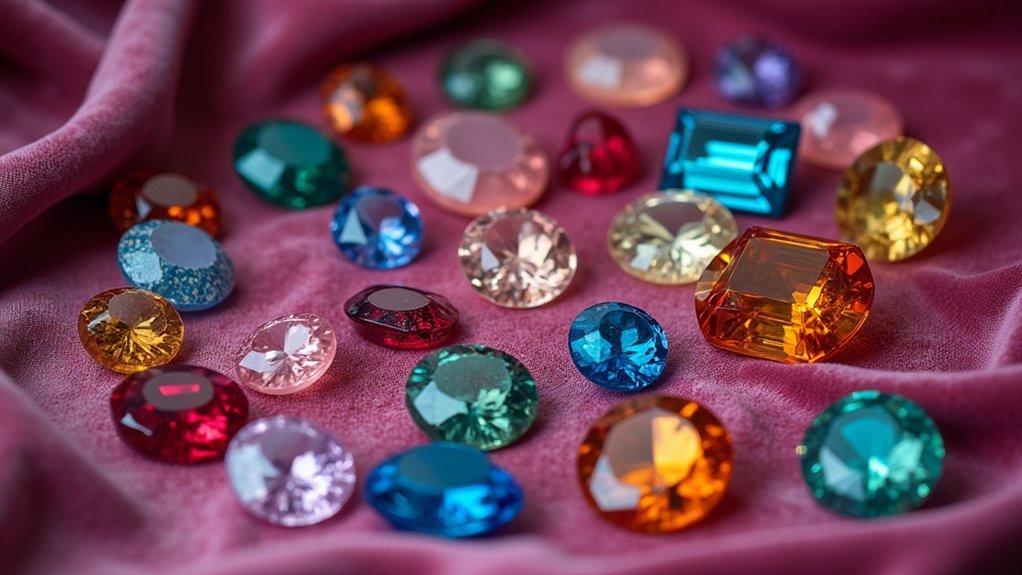
Beyond the joy-focused choices of mood-driven clients lies another fascinating personality type: the Expressive Jewelry Lover. You’ll recognize these clients immediately—they’re drawn to bold, unique pieces that communicate their individuality.
They don’t want jewelry that blends in; they want designs that stand out and reflect their inner self.
When designing for expressive personalities, consider vibrant gemstones and intricate details that evoke emotions and spark conversations.
These clients embrace eclectic combinations, mixing styles and materials that showcase their creativity and open-mindedness.
For expressive clients, bold eclectic jewelry combinations become powerful statements of their unique creativity and adventurous spirit.
Their jewelry choices shift with their moods and social interactions, so offer versatile pieces that can adapt to different emotional states while maintaining that distinctive flair they crave.
Reading Style Preferences: Minimalist vs. Bold Choices
You’ll quickly notice whether your client gravitates toward clean lines and subtle elegance or craves attention-grabbing pieces that make bold statements.
Their jewelry preferences reveal core personality traits—minimalist choices often signal someone who values order and clarity, while bold selections indicate a dynamic, confident spirit.
Understanding these style indicators helps you craft pieces that truly resonate with their inner identity and aesthetic vision.
Minimalist Design Indicators
When clients choose delicate stacking rings over statement pieces or reach for simple stud earrings instead of chandelier drops, they’re revealing their minimalist sensibilities that go far beyond surface-level style preferences.
You’ll notice these clients prioritize functionality and versatility, seeking pieces that seamlessly shift between casual and formal settings. Their selections reflect introversion and subtle self-expression, communicating style in reserved ways.
Watch for their emphasis on quality over quantity—they’ll invest in well-crafted, timeless pieces that resist trend fluctuations. Their detail-oriented nature emerges through preferences for clean lines, geometric shapes, and superior craftsmanship rather than ornate embellishments.
These indicators help you understand their appreciation for understated elegance and simplicity.
Bold Statement Preferences
Chunky cocktail rings, cascading chandelier earrings, and layered statement necklaces signal clients with bold personalities who aren’t afraid to command attention through their jewelry choices.
You’ll notice these clients gravitate toward elaborate pieces that reflect their extroverted, confident nature. They’re drawn to vibrant gemstones like rubies and emeralds, using jewelry as emotional expression and personal storytelling.
Unlike minimalist enthusiasts who appreciate simplicity, your bold clients seek unique, eye-catching designs that embody their individuality.
They’re willing to experiment and push boundaries, showcasing dynamic personalities through distinctive accessories. When designing for these clients, think dramatic silhouettes, rich colors, and intricate details that’ll satisfy their desire to stand out and make powerful fashion statements.
Personality Through Choice
Every jewelry choice your client makes tells a story about their inner world and social preferences.
When you’re analyzing their style tendencies, you’ll discover that minimalist preferences often signal introverted personalities who value order, restraint, and functional elegance. These clients typically appreciate simplicity as a reflection of their thoughtful, deliberate approach to life.
Conversely, clients drawn to bold statement pieces usually exhibit extroverted confidence and creative self-expression. They’re not afraid to attract attention and use elaborate jewelry to communicate their outgoing nature.
Gemstone Selection as Personality Indicators
As you observe a client’s gemstone preferences, you’ll discover powerful insights into their personality and emotional landscape.
Calming stones like amethyst typically attract individuals with peaceful personalities who crave tranquility and balance in their lives. Meanwhile, vibrant gemstones such as ruby draw outgoing, optimistic personalities that reflect energetic and confident natures.
Gemstone preferences reveal deep personality traits—from amethyst lovers seeking peace to ruby enthusiasts embracing bold confidence and vibrant energy.
You’ll notice that softer stones like rose quartz appeal to clients seeking love and compassion, revealing their current emotional states. These preferences often align with individual values and aesthetics, showcasing how personal beliefs influence jewelry selection.
Different gemstones symbolize various personality traits—sapphires represent wisdom and loyalty, serving as subtle indicators of the wearer’s character.
Understanding these connections helps you create designs that truly resonate with each client’s inner self.
Material Preferences and What They Reveal
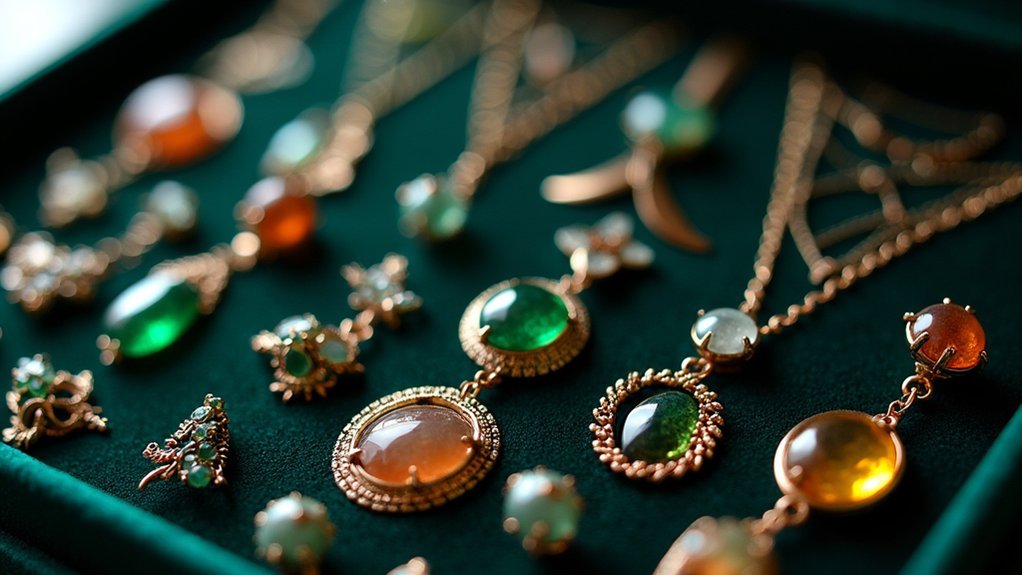
When you’re selecting materials for your jewelry, you’re revealing more about yourself than you might realize.
Your choice between gold’s luxurious appeal and silver’s modern simplicity speaks volumes about your personality and values.
Whether you gravitate toward traditional precious metals or embrace alternative materials like wood and recycled elements, these preferences offer clear windows into your character and lifestyle.
Gold Versus Silver Choices
Why do some clients immediately gravitate toward gold while others instinctively reach for silver pieces?
You’ll find that gold enthusiasts typically embrace traditional elegance and seek to project wealth and sophistication. They’re drawn to timeless luxury and often wear jewelry for formal occasions where prestige matters most.
Silver lovers, however, reveal contemporary personalities that value modern aesthetics and versatility. They appreciate simplicity and functionality, preferring pieces that shift seamlessly from casual to professional settings.
You’ll notice they’re often more open-minded and adaptable in their style choices.
These material preferences tell you everything about your clients’ lifestyles and values. Gold signals formality and tradition, while silver indicates practicality and everyday wearability, helping you design pieces that truly resonate.
Alternative Material Personalities
Beyond precious metals lies a fascinating domain where material choices reveal your clients’ deepest values and lifestyle philosophies.
When someone gravitates toward wood or recycled metals, you’re dealing with a free spirit who prioritizes environmental consciousness and nature connection.
Leather and fabric enthusiasts typically embrace comfort over formality, preferring individuality to conventional elegance.
Resin and acrylic lovers showcase creative, playful personalities who crave uniqueness and custom designs that make bold statements.
Practical souls choose stainless steel or titanium, valuing durability and minimal maintenance over flashy aesthetics.
Clients drawn to handmade artisan pieces reveal their appreciation for authentic craftsmanship and personal connection.
They’re seeking stories behind their jewelry, not just accessories.
Understanding these material preferences helps you craft designs that truly resonate with each client’s core identity.
Classic vs. Contemporary Design Inclinations
Although jewelry preferences vary widely among clients, understanding whether someone gravitates toward classic or contemporary designs serves as a fundamental compass for creating pieces that truly resonate.
You’ll find classic design enthusiasts naturally drawn to timeless elegance—simple pearl strands, gold bangles, and non-fussy pieces that emphasize longevity. These clients typically prioritize professional appropriateness and modesty, selecting jewelry with minimal movement that won’t distract in workplace settings.
Contemporary design lovers, however, seek bold innovation and personal expression. They’re attracted to unique pieces that reflect their individuality and aren’t afraid to mix and match for dynamic looks.
Key indicators to watch for include:
- Professional environment requirements
- Self-expression versus conformity preferences
- Attitude toward mixing different jewelry styles
Understanding these inclinations helps you curate collections matching their aesthetic preferences and lifestyle choices.
Translating Personal Stories Into Custom Pieces
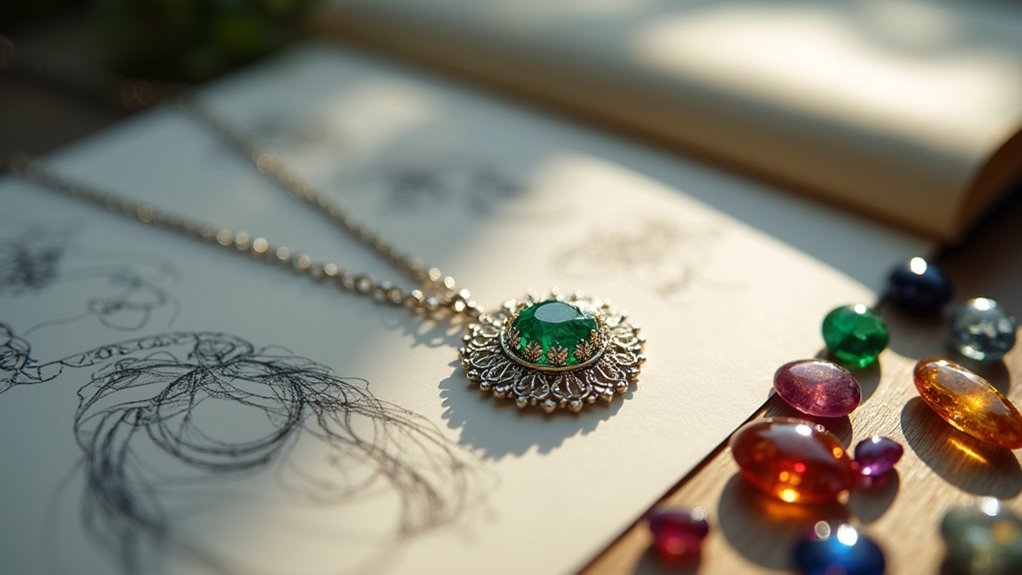
The most meaningful jewelry pieces emerge from deeply personal narratives that clients share during intimate consultations.
You’ll discover that understanding their personal story becomes essential for translating experiences into designs that resonate emotionally and reflect their unique identity. When clients share significant life events, milestones, or memories, you’re gaining invaluable guidance for the design process.
Listen attentively to uncover important details that’ll inform your creation. This prevents developing jewelry that lacks emotional depth or personal significance.
Attentive listening reveals the crucial details that transform ordinary jewelry into deeply personal, emotionally resonant treasures.
Your emotional investment in this collaborative process often leads to unexpected and profound outcomes. The final piece emerges from deep human experiences rather than mere aesthetics, ensuring an intentional and respectful approach that honors their narrative and emotional connections.
Building Trust Through Personality-Driven Design Approach
Trust forms the foundation of exceptional jewelry design, and you’ll build this essential connection by recognizing that each client’s personality shapes their deepest desires for their custom piece.
When you align your approach with their individual traits, you create collaborative partnerships that honor their emotional shifts and personal milestones.
Your personality-driven methodology strengthens client relationships through:
- Active listening during consultations – uncovering unique stories that inform design decisions
- Respecting emotional changes – especially with sensitive projects like heirloom transformations
- Creating meaningful pieces – that serve as lasting legacies reflecting their true identity
Frequently Asked Questions
Who Is the Target Audience for Jewellery Business?
You’ll target women aged 25-55 with disposable income who value self-expression and meaningful gifts. They’re active on social media, appreciate quality craftsmanship, and purchase jewelry for special occasions or personal style enhancement.
What Is the 2:1:1 Rule for Jewelry?
You’ll follow the 2:1:1 rule by pairing two statement jewelry pieces with one minimalist piece and one classic piece. This creates visual balance, letting bold items shine while maintaining elegance and coherence.
What Do You Call a Person Who Designs Jewelry?
You’d call someone who designs jewelry a jeweler or jewelry designer. They’re skilled artisans who blend creativity with technical expertise, crafting unique pieces that translate personal stories into wearable art.
What Are Three Words to Describe Jewelry?
You’d describe jewelry as meaningful because it carries personal stories, timeless since classic styles endure across generations, and expressive as it allows you to showcase your unique personality and identity.
In Summary
You’ve learned to decode your clients’ personalities through careful observation and active listening. By recognizing whether they’re sentimental collectors, bold statement-makers, or minimalist enthusiasts, you’ll create jewelry that truly reflects their essence. Remember, it’s not just about crafting beautiful pieces—you’re translating their stories, emotions, and lifestyle into wearable art. This personalized approach transforms transactions into meaningful relationships, ensuring your clients don’t just wear your jewelry—they cherish it as an extension of themselves.

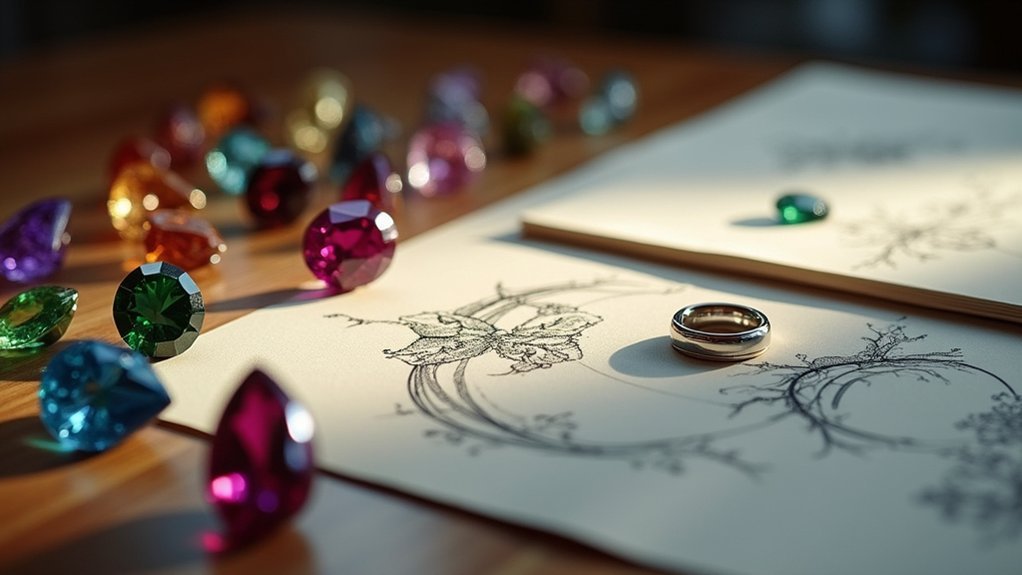



Leave a Reply